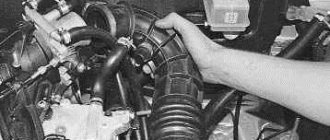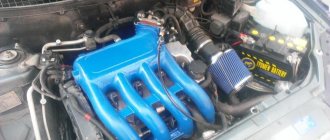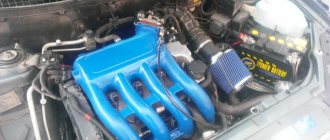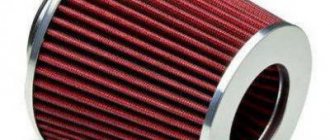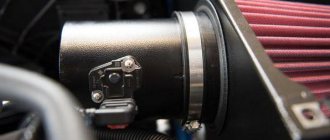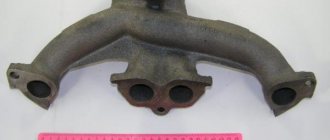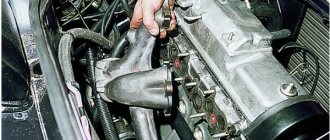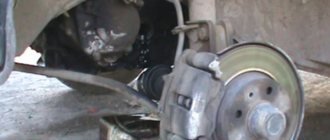The intake manifold, or as it is popularly called the receiver, is a device that ensures a uniform flow of purified air into the cylinder head. The Priora receiver is subject to tuning and modifications, which we will talk about in this article.
In addition, the receiver accumulates air and smoothes out its vibrations, thereby ensuring smooth engine operation due to a uniform (without drops) supply of air masses. When the unit operates correctly, a highly saturated air-fuel mixture is supplied, and lower fuel consumption is achieved when the engine is running.
Reasons for replacing the Lada Priora receiver
There are a considerable number of varieties of intake manifolds, for example, made from various types of metals or composite materials. However, the Priora receiver is made entirely of plastic. This material prevents excessive heating of the manifold due to a hot car engine.
Thus, the air flow characteristics are improved, which has a positive effect on the proportions and quality of the air-fuel mixture. However, plastic also has a main, negative side - fragility. As a result, numerous breakdowns occur both due to the fault of the car owner and due to low temperatures at which the plastic loses its strength coefficient.
The most common damage can be caused by: - road traffic accidents (even minor ones); — accidental impacts during any repair work in the engine compartment; — other reasons;
If the receiver on your car has through holes or any other leaks, then it must be repaired (if possible) or replaced. If a part is faulty, air loss will occur, resulting in improper engine operation.
Replacing the intake manifold on a Prior
Welcome! Intake manifold - someone calls this part an intake manifold and someone calls it a receiver, but if you read the terminology of these two words, these are completely different things, for example, a receiver is needed only to smooth out the pulsations of air that goes into the cylinders of a car engine, but the manifold is already needed in order to distribute this air to the necessary cylinders and the fuel-air mixture is also mixed in it, so these are two different things, but since people call them with the same words, you can assume that they are one and the same thing yes and besides, the can itself at the intake manifold can essentially be called a receiver, since it contains only air and has a fairly large volume, and if you remember the terminology, it says, the receiver is the thing in which the smoothing of air pulsations occurs (The car is moving in this case, more smoothly) and it has a size 50-70% larger than the car’s cylinders, so the receiver and intake manifold can be considered a single whole, but this no longer applies to carburetor cars.
Note! To replace the intake manifold on a car, you will need to stock up on: A set of wrenches and to all this, a socket wrench of size “8” will also come in handy; in addition to this wrench, you will also need various kinds of screwdrivers, wire cutters, or instead of them, you can also stock up on a knife (Knife By the way, it will even be more comfortable)!
Summary:
Where is the intake manifold located? In all sixteen valve engines, even though this is even a sixteen valve engine that was installed on cars of the tenth family (It’s just that the 16 valve engine of the VAZ 2110 car is slightly different from the Priorov’s), the intake manifold is in the same place and they have an absolutely identical shape and design made of plastic, so for clarity, the collector in the photo is indicated by an arrow, but the car as you see is a VAZ 2110, but on the Priors it will be visually the same.
Note! To fully see the collector, you will also have to remove the engine screen, the screen is a thing that reduces the noise from the engine a little and covers it from dirt getting on it. When carrying out a lot of work, you will have to remove this screen because it covers almost the entire part of the engine and itself Moreover, you will not see the collector without removing the screen from the car; for more details on how to remove this screen, read the article: “Replacing the engine screen on cars”!
When should you replace the intake manifold? Since the collector on Priors is made of plastic, it is not so difficult to bend it or pierce it with anything, dropping it, for example, on a sharp stone from a height, besides this, the collector is no longer necessary to be replaced in any case (with the exception of replacing it with some be it sports), but the manifold also needs to be removed in the following cases, firstly, when carrying out any work due to which the manifold interferes, and secondly, the manifold has its own gaskets (the intake manifold has only five of them, one of them is located between throttle valve and manifold, and the other four at the end of the pipe are installed, how to replace them as you read the article, you will find out) when they wear out, the air begins to come out, and if the air is simply released (that is, comes out), then the car will drive worse and its consumption will increase , since you will have to press your foot harder on the gas pedal.
How to remove the receiver on a Priora
Tools that may come in handy: - 10mm socket; - key 13; - screwdriver.
To remove the intake manifold you will need:
- Due to the fact that in the next steps of the instructions there will be manipulations with electrical wiring, it is necessary to remove the negative terminal of the battery.
- The next step is to remove the plastic screen (cover) from the engine housing. This is done so that it does not interfere with your work.
- After which, it is necessary to remove power from the four ignition coils and dismantle them. To do this, pull out the contact chips. Take a 10mm socket (or a wrench of the same size) and unscrew one fastening bolt on each coil. Simply pull the coils upwards using the necessary force. Now they can be removed. There is no need to remove the spark plugs themselves; they will not interfere with removal. On the other hand, it is advisable to take advantage of the situation and check their condition (gap and spark quality).
Removing the intake manifold
It is removed either for replacement or when repairing the ramp and injectors. Polishing the intake manifold will also help, as this will make it easier for fuel to enter the combustion chambers. Consequently, the power will increase. It is necessary to begin work by reducing the pressure in the fuel system. This can be done by removing the fuse for the fuel pump and starting the engine.
Wait until the engine stops on its own. This will indicate that there is no gasoline left in the system and the pressure has dropped. Now disconnect the battery and begin dismantling the system elements. First you need to remove the decorative casing, which is located on the top of the engine. It is attached at three points. Then proceed to dismantle the air filter. Remove the pipes that go to it.
Having freed up space, you can begin to remove the throttle assembly. There will be no problems with its dismantling, the main thing is not to remove the screws securing the damper. Otherwise, if you do not tighten and secure it properly, it may fall out and go into the engine. Then you will have to carry out large-scale repairs, which can be compared with a major one. With the throttle assembly removed, you can begin removing the intake manifold. Installation is carried out in reverse order.
Installing a receiver on a Priora
As usual, installation is carried out in the same way as removal, however, during its production you must be extremely careful not to damage the receiver body. It is extremely important to insert the installed part with the holes into the connecting pins of the cylinder block, after which the manifold is directed to the mounting points on the engine.
Small but important points for installation:
- always clean or lubricate the rubber seals installed at the points of contact between the receiver and the cylinder block;
- Properly tighten the nuts at the joints of the elements.
Which receiver is better for Priora?
There is no clear answer to this question. Each situation is individual. However, some comparisons can be made between receivers made of plastic and aluminum.
Advantages of aluminum products:
- higher strength and wear resistance;
- increased engine power due to design features and a larger volume of supplied air;
- Some models are easier to install and therefore easier to remove.
In addition, the shape of the collector itself plays an important role in ensuring increased power, which should not contain sharp corners and transitions. The most important difference between plastic and metal is the strength and durability of the latter. Therefore, we can recommend installing metal types of intake manifolds for Lada Priora cars.
Operations performed when replacing the cathode collector on a VAZ 2170 2171 2172 Lada Priora
The nuts securing the catalytic converter to the cylinder head are difficult to access. In addition, the collector flange is sealed with a metal-reinforced gasket. The sealing gasket must be replaced every time the connection is disassembled. Before removing the catalytic converter, it is necessary to remove the intake manifold - this will facilitate access to its mounting.
1. Remove the decorative engine casing (see “Removing and installing the decorative engine casing on a VAZ 2170 2171 2172 Lada Priora” ).2. Remove the wire from the negative terminal of the battery.3. Disconnect the exhaust pipe of the additional muffler from the exhaust manifold by unscrewing the nuts securing the intake pipe flange to the exhaust manifold flange and remove the exhaust pipe flange from the studs of the exhaust manifold flange (see “Replacing the additional muffler on a VAZ 2170 2171 2172 Lada Priora”). 4. Remove the air filter (see “Removing and installing the air filter on a VAZ 2170 2171 2172 Lada Priora”).
5. Remove the air supply hose and three hoses of the crankcase ventilation system (see “Cleaning the crankcase ventilation system on a VAZ 2170 2171 2172 Lada Priora”).
6. Disconnect the four connectors of the ignition module wiring harness and move the harness to the side. Remove the ignition modules (see “Removing and installing ignition coils on a VAZ 2170 2171 2172 Lada Priora”).
Review of the exhaust system of Lada Priora
The exhaust gas exhaust system on the Lada Priora performs the following functions:
- exhaust gas removal;
- noise reduction when the engine is running;
- neutralization of toxic hazardous substances in exhaust gases.
The basis of the Priora exhaust system includes:
- 1. Exhaust manifold with converter;
- 2. Resonator;
- 3. Main muffler;
- 4. Auxiliary muffler;
- 5. Connecting pipes.
The manifold is used to remove exhaust gases from the cylinders into the exhaust pipe. The tightness of the connections is ensured by sealing with a metal gasket in two layers between the block head and the exhaust manifold. The attachment of the exhaust manifold to the cylinder head on one side goes into connection with the converter on the other. The collector and converter connected into one unit make it possible to reduce the warm-up time to the operating temperature of the latter, which significantly increases the efficiency of the converter.
Installation of oxygen concentration sensors at the inlet and outlet of the converter ensures constant monitoring of the quality of exhaust gases. The connection between the intake pipe and the manifold has a heat-resistant seal in the form of a metal-asbestos gasket. And the metal compensator connecting the additional muffler with the exhaust pipe serves as a vibration damper from the engine to the body and the entire exhaust system.
The exhaust gas exhaust system is connected by attaching it to the body brackets using 4 rubber rings. On the main muffler, the suspension cushion has a reinforced structure, which is due to the increased load on it.
What is a “spider” for Priora and what is it for?
Tuning the exhaust system of the Lada Priora includes replacing the exhaust manifold with a similar sports version, which is called the “spider”. The main difference between the original manifold and the spider is that the latter has a larger diameter and the same length of outlet pipes, which facilitates the rapid release of exhaust gases from the cylinders to the exhaust pipe.
This spider design prevents exhaust gases from flowing back into the combustion chamber, which increases engine power and performance. In addition, the manifold performs the function of purging the combustion chamber and filling it with a combustible mixture due to the pressure that is created when exhaust gases are released.
To tune the Priora exhaust system, a ready-made kit for installing a direct-flow Stinger exhaust with additional components that are perfectly attached to each other is often used. As a rule, the tuning kit includes the following parts:
- new muffler with nozzle;
- spider;
- resonator Stinger Sport with a pipe diameter of 51mm.
The need to install a “spider” on Priora arises when:
- long vehicle acceleration time;
- low engine power;
- failure of the old exhaust system, where installing a spider on a Priora is considered as an alternative to the old one.
On the tuning parts market there are many modifications of “spiders” made by different manufacturers. Some models are produced without oxygen sensors, which requires reflashing the electronic engine control unit.
There are spiders with long and short pipes, which are indicated by the corresponding numbers 4-2-1 and 4-1. These designations reflect the shape of the spider pipes, that is, 4 pipes merge into 2, and then into 1, in the second option, respectively, 4 pipes are immediately combined into one, which significantly reduces the length.
The most popular among car enthusiasts has become the long spider 4-2-1, which, unlike the short one, shows good results in a wide speed range. A short spider 4-1 is better suited for forced engines operating at 6-10 thousand rpm.
Advantages and disadvantages of installing a spider on a VAZ 2170
After installing the “spider” on the VAZ 2170, Priora owners note the following positive changes in its operation:
- the car accelerates faster;
- the maneuverability of the car on the road improves;
- the engine sound is reminiscent of a sports car engine;
- the engine becomes more powerful up to 10 hp;
However, often a change in the design of the exhaust system associated with the installation of a spider can also have negative consequences:
The nuts securing the catalytic collector to the Priora cylinder head are difficult to access. In addition, the collector flange is sealed with a metal-reinforced gasket. The sealing gasket must be replaced every time the connection is disassembled. Before removing the catalytic converter, it is necessary to remove the intake manifold - this will facilitate access to its mounting.
- 1. Remove the decorative engine cover (see “Removing and installing the decorative engine cover for the VAZ 2171”).
- 2. Remove the wire from the negative terminal of the battery.
- 3. Disconnect the exhaust pipe of the additional muffler from the catalytic collector by unscrewing the nuts securing the exhaust pipe flange to the catalytic collector flange and remove the exhaust pipe flange from the studs of the VAZ 2170 catalytic collector flange (see “Replacing the additional muffler”).
- 4. Remove the air filter (see “Removing and installing the air filter”).
5. Remove the air supply hose and three hoses of the crankcase ventilation system of the VAZ 2170 (see “Cleaning the crankcase ventilation system”).
6. Disconnect the four connectors of the ignition module wiring harness and move the harness to the side. Remove the ignition modules (see “Removing and installing ignition coils”).
7. Remove the throttle assembly.
8. Remove the intake manifold of the VAZ 2172 (see “Replacing the cylinder head cover gasket of the Lada Priora”).
9. Disconnect the wiring harness blocks of the control and diagnostic oxygen concentration sensors from the engine harness...
10. ...and disconnect the holders of the wiring harnesses of the control and diagnostic oxygen concentration sensors from the heat-insulating shield of the steering mechanism
11. Unscrew the three nuts securing the thermal insulation shield of the Lada Priora steering mechanism to the engine shield and remove the shield.
- 12. Unscrew the two nuts securing the water pump supply pipe bracket, unscrew the bolts securing the catalytic collector to its mounting bracket, unscrew the eight nuts securing the catalytic collector to the Priora cylinder head and remove the catalytic collector. Disconnecting the catenary collector from the cylinder head and troubleshooting it is described in detail in the subsection “Replacing the catenary collector gasket”.
- 13. Remove the sealing gasket of the catenary collector from the cylinder head studs.
- Be sure to replace the sealing gasket of the catalytic collector and inlet pipe with a new one every time you disassemble the connection.
- 14. Clean the flanges of the block head and catalytic collector from the remains of the old gasket and carbon deposits.
- 15. Unscrew both oxygen sensors from the VAZ 2171 catenary collector and install them on the new VAZ 2172 catenary collector.
- 16. Install the cathode collector and all removed parts and assemblies in the reverse order of removal.
To prevent the gasket from sticking and to improve its tightness, we recommend lubricating the gasket on both sides with a thin layer of graphite grease before installation.
Lubricate the mounting studs of the Priora exhaust manifold with graphite grease.
Sooner or later, the car needs to be repaired. In some places the replacement must be carried out as planned, in others it is not. But every car owner faces a similar problem.
The question immediately arises: what repairs can you realistically carry out on your own, and where do you need to go to a car service center? Thanks to the Internet, all the necessary information, even with video instructions, can be found quickly.
The main function of the manifold is to distribute air among the engine cylinders, and also mix the fuel-air mixture there. And if you do not diagnose the operation of the air system in a timely manner and do not pay attention to the symptoms, this can lead to more serious engine damage.
The sequence of work is as follows
First, the pipe of the additional muffler, which is connected to the catalytic collector, is disconnected. To do this, you need to bend the edges of the plate and unscrew the fastening nuts. Is this where you need a key for 13? with additional extension cord. After this, the locking plate is removed. Once the locking plate is removed, the heat shield is removed. The flange of the muffler pipe is moved, after which the sealing gasket is removed from the studs of the catalyst manifold. After this, the blocks with contact wires are disconnected from the oxygen concentration control and diagnostic sensors installed on the catenary collector. To remove the exhaust manifold, you need to unscrew the two bolts that secure the exhaust manifold to the car engine cylinder block. For these purposes, a 13? key head is used. After the bolts are unscrewed, the catcollector bracket is removed.
By the way, if the starter fails, we recommend looking for it on the website https://www.startvolt.com/catalogue/startery/gaz/.
To remove the collector, you need to unscrew the nut on the rear engine mount and loosen the bolt securing the engine mount to the car body. After this, you need to remove the bolt on the engine mount. Unscrew the three nuts securing the support bracket to the cylinder head. After loosening the nuts, the bracket moves along the cylinder head studs.
The fastening nut on the supply pipe of the coolant supply pump is unscrewed. After loosening the fastening of the bracket to the pump pipe stud, the bracket is moved away from the cylinder head. The eight nuts securing the exhaust manifold are removed. For this purpose, a 13? head is used. The exhaust manifold of the Lada Priora car moves along the cylinder head studs and is pulled down.
Determining whether the engine is sucking in air
Before you start removing more than half the engine parts to get to the manifold, you should check other parts of the air system. And after that, carry out a complete tuning of the car. First of all, you need to inspect all the hoses and gaskets located on the cylinder block.
The most common method of finding air leaks is to spray the hoses with plain water; if there is a hole in one of them, the engine speed will decrease when water enters.
Detailed instructions for removing the intake manifold on a new Priora
It is necessary to remove parts from a cooled engine. It will take about an hour, provided that you have at least a little understanding of the injection system. The following sequence of actions must be followed:
- First of all, you need to remove the throttle. There is no need to completely remove it, just move the assembly connecting it to the manifold to the side. You also need to remove the throttle valve to thoroughly clean everything;
- disconnect the drive throttle cable from the manifold;
- disconnect the connectors from each other to remove the wires from the ignition coils;
- on the camshaft, disconnect the sensor wires;
- disconnect all canister wires;
- disconnect the brake booster vacuum hose going to the manifold;
- then unscrew the clamp and remove the ventilation pipe;
- Unscrew the self-tapping screw of the oil level indicator guide tube;
- remove the dipstick with the guide tube;
- using sockets and a ten-size wrench, unscrew the nuts and bolts securing the exhaust module and coils from cylinders 1-2-3;
- remove the coils;
- then you need to unscrew the collector fasteners;
- slide it forward and remove the manifold.
Replacing the intake manifold on a Prior
Welcome! Intake manifold - someone calls this part an intake manifold and someone calls it a receiver, but if you read the terminology of these two words, these are completely different things, for example, a receiver is needed only to smooth out the pulsations of air that goes into the cylinders of a car engine, but the manifold is already needed in order to distribute this air to the necessary cylinders and the fuel-air mixture is also mixed in it, so these are two different things, but since people call them with the same words, you can assume that they are one and the same thing yes and besides, the can itself at the intake manifold can essentially be called a receiver, since it contains only air and has a fairly large volume, and if you remember the terminology, it says, the receiver is the thing in which the smoothing of air pulsations occurs (The car is moving in this case, more smoothly) and it has a size 50-70% larger than the car’s cylinders, so the receiver and intake manifold can be considered a single whole, but this no longer applies to carburetor cars. Note! To replace the intake manifold on a car, you will need to stock up on: A set of wrenches and to all this, a socket wrench of size “8” will also come in handy; in addition to this wrench, you will also need various kinds of screwdrivers, wire cutters, or instead of them, you can also stock up on a knife (Knife By the way, it will even be more comfortable)!
